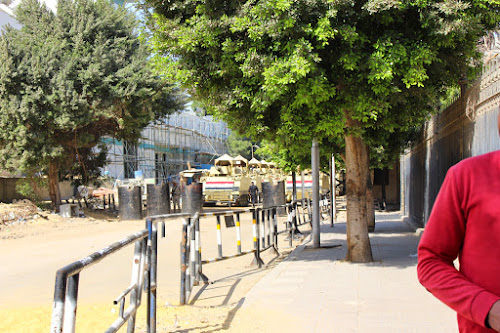The Egyptian Museum is just unbelievable. We have seen various Egyptian exhibits at the Met, the Louvre and the British Museum, plus we saw the traveling Tutankhamon exhibit when it came to the BC Royal Museum. Well, all those combined are but drops in the bucket of Egyptian antiquities housed at the Egyptian Museum (the new one being built near the pyramids should have been ready two years ago but there's still no official opening date) and that is what you can actually see, which is only a tiny fraction of what's kept below in storage, not even catalogued.
There were so many highlights (no photographs allowed so nothing to post here) that it's difficult to list them, but my two favourites were without a doubt, the mummies room and the contents of King Tut's tomb. If there was one thing over which I had mixed feelings, was that having seen the real Rosetta Stone at the British Museum (of which there's only a copy here) I could understand the Egyptians' less than kind feelings about the plundering of their national treasures, which they are very slowly and not very successfully trying to recover.
One thing we observed while in Egypt, was that we felt absolutely safe. There was not much of a military presence in Luxor but in Cairo, around Tahrir Square, there was an amazing show of preparedness, both police and military. Again, at no time did we feel in danger or any kind, only sadness at the damage being done to the Egyptian tourism industry by the overblown media reporting of isolated events. The picture below shows an entire column of tanks at the ready in the narrow street between the museum and the Ritz Carlton.
Egyptian Museum
Tanks at the ready
From the museum we were off to Giza. Some people had told me that after Luxor's magnificence, the pyramids and the Sphinx can be a bit of a let down. Well, let me tell you that's not the case. The pyramids are just as fantastic a sight and the Sphinx, which is perhaps smaller than one may think it is, all together create the most amazing set of monuments set against the backdrop of modern Cairo. A camel ride was also in order; tourist trap? sure, but riding on the back of a camel surrounded by the sheer magnificence of the plateau is quite something.I honestly could have spent hours and hours there, just taking in the ever-changing view of the pyramids; drifting clouds making shadow plays on them, making one look almost white while the next one took the darkest of shades.
To round out our day in Cairo we ate some delicious traditional sweets on our way to the airport. We didn't see much of Cairo itself; we drove from the airport through busy, heavy traffic, mostly along highways and a major road called 6 of October (marking the date of the revolution) where we saw nice examples of the city's arabic and British architecture; we drove by Hosni Mubarak's house (a humongous enclave where no one lives nowadays but which is heavily guarded by the military), and along some of the poorer areas of the city marked by an unending collection of half-finished brick buildings. Our guide told us that those "buildings" where in fact family homes; traditionally, extended families live all in one house but on different floors, so that floors are added as the family grows but the construction never really ends and not much money, if any, is spent on finishings such as stucco, paint, windows, etc.
One sight that surprised me was that on the way to Giza and along what seems to be a canal, the banks are used as a dump by the neighbourhood's inhabitants. I saw women hurtling garbage bags and multitude of birds picking at the monumental amount of rubbish accumulated on either side of the canal. What was surprising to me was that the road is a main route to Giza and therefore one of the tourists' first impressions, and there seems to be no attempt at cleaning it up. On to Mumbai we go.






No comments:
Post a Comment